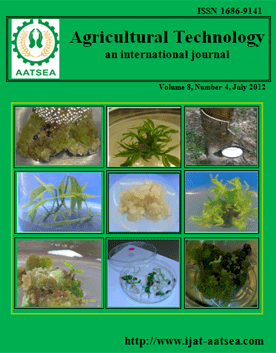ThaiScience
ThaiScience
INTERNATIONAL JOURNAL OF AGRICULTURAL TECHNOLOGY
Volume 15, No. 06, Month NOVEMBER, Year 2019, Pages 933 - 946
The effects of dual modification with ultrasound and annealing treatments on the properties and glycemic index of the thai glutinous rice cultivar ‘rd6’.
Kunyanee, K. and Luangsakul, N.
Abstract Download PDF
Glutinous rice is a popular food and an important source of carbohydrate, especially in the North and North-Eastern areas of Thailand. However, glutinous rice can be considered unhealthy because it has a high glycemic index (GI=75-92), which makes it unsuitable for people suffering with type II diabetes. Therefore, a method of processing glutinous rice that reduces its GI could make it a more acceptable food and more suitable for diabetics. Ultrasound, which applies mechanical waves with a frequency above 16 kHz, and annealing (ANN), which is a hydrothermal treatment, have both been successfully used to modify starch. Ultrasound impacts starch granules and can change molecular structure and properties. ANN can reduce starch hydrolysis and improve its relative crystallinity, which affected its thermal properties. Therefore, the combination of ultrasound and ANN treatments were investigated to determine their effects on the glycemic index of the Thai glutinous rice cultivar ‘RD6’. Samples of ‘RD6’ were treated with ultrasound, at 100% amplitude, for 15 min followed by storage at 4oC for 24 h and then exposed to ANN at 45, 50 or 55oC. The samples were then evaluated for their pasting properties (pasting temperature, pasting viscosity, breakdown, final viscosity and setback), gelatinization properties, starch hydrolysis and glycemic index. All the pasting properties of the ‘RD6’ samples that treated with ultrasound and ultrasound plus ANN had significantly (p<0.05) increased levels of all compared to the untreated samples (control). These treatments also significantly (p<0.05) increased onset temperature and gelatinization enthalpy, particularly the ANN at the higher temperatures (50 and 55oC). In addition, ultrasound plus ANN significantly (p<0.05) decreased starch hydrolysis and promoted a decrease in their glycemic index from (76.78-77.62) as compared to the control (84.14) and ultrasound alone (80.71), but none of these treatments reduced glycemic index to below 70, which is ranked as high.
Keywords
glutinous rice, ultrasound treatment, annealing, and glycemic indexINTERNATIONAL JOURNAL OF AGRICULTURAL TECHNOLOGY
Published by : Association of Agricultural Technology in Southeast Asia (AATSEA)
Contributions welcome at : http://www.ijat-aatsea.com
